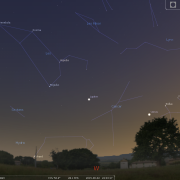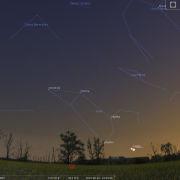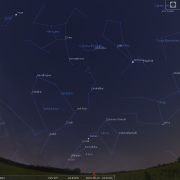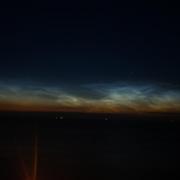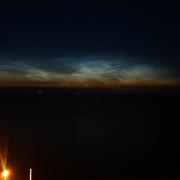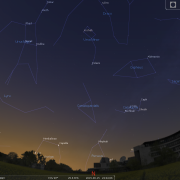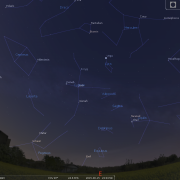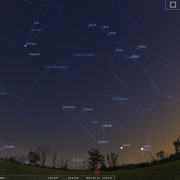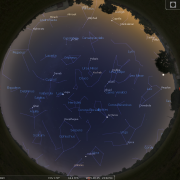In this month's Sky Notes:
Planetary Skylights
 Look to the WNW to find both Venus (left) and Jupiter dominating the late evening twilight sky. At Mag-4.4, Venus is considerably the brighter and at the start of June (2nd) lines up with Castor and Pollux in Gemini. It then passes just above the open star cluster (M44); the Beehive in Cancer on the 12th & 13th.
Look to the WNW to find both Venus (left) and Jupiter dominating the late evening twilight sky. At Mag-4.4, Venus is considerably the brighter and at the start of June (2nd) lines up with Castor and Pollux in Gemini. It then passes just above the open star cluster (M44); the Beehive in Cancer on the 12th & 13th.
 Jupiter and Venus continue to close the gap between them resulting in a spectacular planetary conjunction at the end of June when they are separated by less than one degree in the sky. A modest scope at low power should show both in the same field of view, with Jupiter's Galilean moons (3 on one side and Ganymede on the other) strung out in a line. Venus will appear as a half phase. The young moon lies near both on the 20th, making for a splendid sight.
Jupiter and Venus continue to close the gap between them resulting in a spectacular planetary conjunction at the end of June when they are separated by less than one degree in the sky. A modest scope at low power should show both in the same field of view, with Jupiter's Galilean moons (3 on one side and Ganymede on the other) strung out in a line. Venus will appear as a half phase. The young moon lies near both on the 20th, making for a splendid sight.
 Saturn is making inroads into the evening sky, located low in the SE and to the south by midnight. Saturn resides not that far above the distinctive ‘ruddy’ hue of Antares, chief star in Scorpius. Viewed through a scope Saturn is a glorious spectacle, with the ring system now wide open, the only down side being the relatively low altitude above the horizon which often makes for poorer seeing. Saturn's largest moon; Titan, is visible as a speck close by. Our moon lies nearby on the 1st and also the 28th.
Saturn is making inroads into the evening sky, located low in the SE and to the south by midnight. Saturn resides not that far above the distinctive ‘ruddy’ hue of Antares, chief star in Scorpius. Viewed through a scope Saturn is a glorious spectacle, with the ring system now wide open, the only down side being the relatively low altitude above the horizon which often makes for poorer seeing. Saturn's largest moon; Titan, is visible as a speck close by. Our moon lies nearby on the 1st and also the 28th.
Meteor Activity

The weak Ophiuchid meteor shower has two maxima, June 9th and June 20th. The zenith hourly rate (ZHR) barely exceeds sporadic levels (5 - 8 per hr) Observe post midnight. The poorly observed June Lyrids peak on the 15th/16th, again the ZHR is only 5-6 per hour.
Summer Solstice
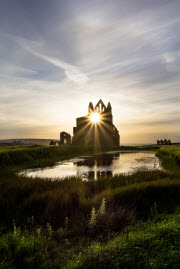
"Whitby Abbey Summer
Solstice" (taken June 2014)
Reproduced with kind
permission: Si's Photography
Click for full-sized image.
Oh dear, half the year misplaced already, and we are rapidly approaching the summer solstice, which falls on June 21st. Before we know it, days will grow shorter and nights longer again! In the northern hemisphere the solstice officially marks the start of summer even though we are almost into the seventh month!
Derived from the Greek for 'sun' and 'to stand still', the solstice (summer) marks the precise time the Sun seemingly halts its movement northwards in the sky, attaining its greatest altitude on the ecliptic; the path the Sun follows across the sky during a year. From our latitude this equates to almost 59 degrees above the southern horizon. Thereafter, the Sun retreats southwards once again as the axial tilt of Earth shifts away from the direction of the Sun.
Because temperatures are warmer in summer many people wrongly assume that Earth is closer to the Sun at this time of year; in fact the opposite is true. Earth is actually furthest from the Sun on July 4; almost 95 million miles distant, three million miles further than when at its closest approach in early January!
The reason days feel warmer in summer is due to the higher concentration of sunlight per unit area, caused by the axial tilt of the Northern hemisphere toward the Sun. On average the intensity of solar radiation is then equivalent to approximately 1.2KW of heat for each square metre, although it can sometimes feel we're being short changed!
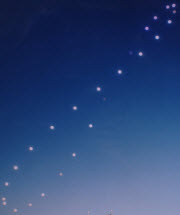
Analemma: Sun's position at
same time of day over a year.
Earth's tilt+eliptical orbit mean
longest day, earliest sunrise
& latest sunset don't coincide.
The summer solstice is also known as the longest day, however earliest sunrise and latest sunset do not occur on this date. From Whitby earliest sunrise actually occurs on June 16th at 04:25am, whilst latest sunset occurs on June 25th at 21:42pm. It is the duration of use able daylight that does reach a maximum on the 21st, which from here amounts to just over 17 hours. With the Sun dipping barely 12 degrees below the horizon, it's no wonder nights are so light, even nautical twilight is relatively short lived. Any place north of the Arctic Circle will see the sun above the horizon for 24hrs, indeed it was rather interesting to note how the background twilight levels varied during the Eurovision voting jury segment. Certainly, background skies from Scandinavian countries were a good deal lighter, making it looks as though they were voting earlier in the day.
Thousands of years ago the position of the summer solstice in the northern hemisphere stood before the stars of Cancer, but has subsequently shifted due of the effects of precession, Earth's slow axial wobble and now stands on the Gemini/ Taurus border. Anywhere on the Earth's surface between latitude 23.5 degrees North and latitude 23.5 degrees South,, the Sun can appear overhead, casting no shadows, a phenomena astronomers in antiquity duly noted.
Because the summer solstice then stood before Cancer, the latitude of 23.5 degrees north eventually became known as the tropic of Cancer. Similarly, as the Sun then stood before the stars of Capricorn at its southern limit on the ecliptic, (the winter solstice) some 23.5 degrees south of the celestial equator, the same latitude on the Earth became known as the tropic of Capricorn. So, rejoice summer is almost upon us, time to don a druids cloak and go and admire some large standing stones.. if that’s your thing.
With bright twilight now persisting well into the night, observers of the sky may like to keep an eye open for a particularly beautiful type of cloud formation seen only at this time of year. Known as Noctilucent cloud, these delicate formations appear in the twilight sky above the northern horizon, long after sunset, even after midnight. Shining quite brightly, Noctilucent cloud is filamentary in structure, having a characteristic silvery-blue colour.
It forms almost exclusively between latitudes 50 and 60 degrees north, high in the upper atmosphere: 50 miles up- five times higher than normal clouds. The cloud forms when water vapour condenses at the low temperatures that prevail at such altitudes onto particles suspended in the air. More frequent sightings of Noctilucent cloud over the last 40 years may indicate that these particles could be a result of industrial pollution, perhaps from increased air traffic.
As far as observers of the sky are concerned, the right type of cloud, for the wrong reasons! Certainly, some of my observing highlights the past two summers have been displays of Noctilucent cloud so do keep a watch!
|
Looking South
Mid June - 23:00h |
Looking North |
|
Looking East
Mid June - 23:00h |
Looking West
Mid June - 23:00h |
|
|
|
|
Overview
Mid June - 23:00h |
|
Additional Image Credits:
- Planets and Comets where not otherwise mentioned: NASA
- Sky Charts: Stellarium Software
- Log in to post comments

